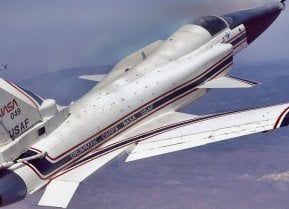EA-6B Prowler: The Warplane the Marines Wish They Never Retired?
The twin-engine, four-seat, mid-wing electronic-warfare EA-6B Prowler was derived from the A-6 Intruder, an all-weather attack aircraft developed and manufactured by Grumman Aerospace in the late 1950s.
Meet the EA-6B Prowler: On March 14, 2019, the United States Marine Corps' last EA-6B Prowler made its final fight.
It wasn't over enemy territory and the four-person crew likely could take in the view for a change. It was a monumental flight, as the four members of the Marine Tactical Electronic Warfare Squadron 2 (VMAQ-2) were delivering the aircraft from their station at Cherry Point, North Carolina to the Smithsonian's National Air and Space Museum.
In a nod to history, the crew even took a quick detour to fly over the Northrop Grumman factory in Bethpage, New York, where the aircraft had been built.
The Grumman Intruder
The twin-engine, four-seat, mid-wing electronic-warfare EA-6B Prowler was derived from the A-6 Intruder, an all-weather attack aircraft developed and manufactured by Grumman Aerospace in the late 1950s. Selected from eleven competing designs in December 1957, the Intruder was specifically planned for first-pass blind attack on point surface targets at night or in any weather.
It was designed to be subsonic, and was powered by two straight turbojets. Despite having a considerable gross weight that was heavier than most heavy World War II four-engine bombers, the Intruder was developed as a short takeoff and landing (STOL) aircraft for close air support, and to replace the Douglas A-1 Skyraider.
The crew sat side-by-side under a broad sliding canopy, which provided a marvelous view in all directions. The navigator controlled the extremely comprehensive navigation, radar and attack systems known as the Digital Integrated Attack Navigation Equipment or DIANE. In Vietnam, the A-6A worked round the clock making pinpoint attacks, which could not be accurately undertaken by any other aircraft until the arrival of the F-111.
Enter the EA-6B Prowler
Development of the more advanced EA-6B Prowler began in 1966. It also had an aircrew that consisted of a pilot and three Electronic Countermeasure Officers, and it carried an advanced ECM (electronic countermeasures) suite, yet still retained partial attack capabilities.
Electronic warfare had been around since the advent of radar in World War II, but Cold War era Prowler was the first tactical electronic warfare airplane designed from the ground up.
Though it was introduced in the latter stages of the Vietnam War, the Prowler remained in service with the United States military until 2019. It carried out a variety of missions that included jamming enemy radar systems as well as gather radio intelligence on enemy air defense systems. With the retirement of the United States Air Force's EF-111 Raven in 1998, the EA-6B Prowler was the only dedicated electronic warfare plane until the introduction of the U.S. Navy's EA-18G Growler in 2008.
Combat Record
The first Prowlers arrived at VAQ-129 at NAS Whidbey Island, Washington, in December 1971, and the initial fleet squadrons equipped with the EA-6B flew combat missions over North Vietnam as part of Operations End Sweep followed by Operation Linebacker II in 1972. The Prowlers successfully jammed North Vietnamese radars and communications in support of tactical strikes and high-altitude attacks, and the aircrafts' successes convinced U.S. Navy officials that every carrier air wing should include an EA-6B squadron, and it initiated production to equip eight 4- plane squadrons by 1975.

Over the next five decades, the Prowler supported combat missions in Grenada, Lebanon, Libya, Iraq, Bosnia and Afghanistan as well as in other crises around the world.
During air operations in Operation Desert Storm in 1991, the EA-6B proved critical to the success of all aviation missions as U.S. Navy Prowlers determined threat locations and then subsequently jammed and destroyed enemy radars. In addition, U.S. Navy defense suppression aircraft supported all U.S. and coalition forces, and availability of the EA-6Bs was typically a go/no-go criterion for many strike missions. If US. Navy defense suppression wasn't available, the missions didn't fly.
Surviving Aircraft
A total of 170 EA-6B Prowlers were constructed by Grumman, and not a single one was ever shot down in combat.
However, fifty were lost over the years in accidents. A total of twenty-seven are now on display at various military and aviation museums around the United States, while one is also on display at the Naval Air Facility Atsugi in Yamato, Kanagawa, Japan.
Visitors to the Smithsonian's National Air and Space Museum can see the Prowler that made its final flight in 2019, with its wings folded sitting next to its sibling, the Grumman A-6E. If only they could share their stories.
About the Author
Peter Suciu is a Michigan-based writer who has contributed to more than four dozen magazines, newspapers and websites. He regularly writes about military hardware, and is the author of several books on military headgear including A Gallery of Military Headdress, which is available on Amazon.com. Peter is also a Contributing Writer for Forbes.


